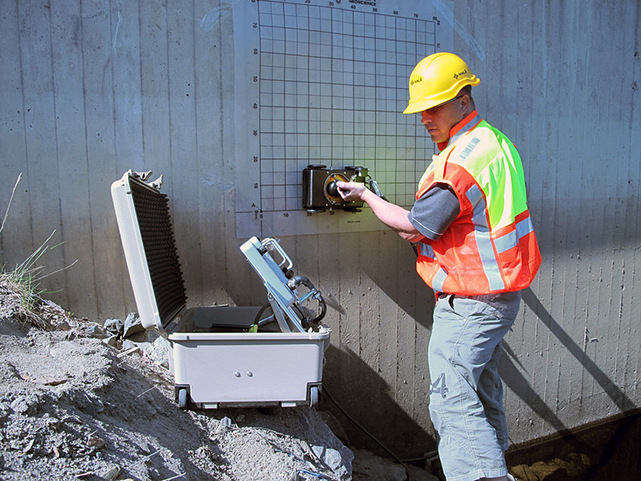Beyond the Surface: Leveraging Advanced Concrete Scanning Techniques for Unmatched Accuracy and Insight
Advanced concrete scanning techniques have actually emerged as important devices in this quest, providing a glance underneath the surface area to introduce a globe of crucial understandings. By taking advantage of innovative technologies, experts can discover abnormalities, analyze the condition of concrete frameworks, and make informed choices that shape the training course of tasks.
Relevance of Advanced Concrete Scanning
The importance of using sophisticated concrete scanning strategies lies in the exceptional precision they use for finding sub-surface abnormalities and ensuring structural stability. By utilizing advanced modern technologies such as ground-penetrating radar (GPR), electromagnetic induction, and progressed sonar imaging, building experts can delve underneath the surface of concrete frameworks with a level of precision that far goes beyond typical evaluation methods. Concrete Scanning. These strategies make it possible for the identification of surprise dangers like rebar corrosion, spaces, channels, or post-tension cables that might jeopardize the stability and security of a framework in time
Furthermore, advanced concrete scanning gives invaluable insights right into the general condition of a concrete component without the demand for invasive procedures, reducing the threat of causing damage throughout the analysis procedure. The capability to identify the precise area and deepness of potential concerns allows for targeted repair services and upkeep, ultimately prolonging the life expectancy of the structure and optimizing its efficiency. Essentially, the value of advanced concrete scanning can not be overstated in the world of building and facilities upkeep, where accuracy and dependability are extremely important.
Kinds Of Cutting-Edge Technologies

Anomalies and Issue Detection

Along with GPR, concrete scanning strategies like thermography and impact-echo testing are likewise reliable in finding abnormalities and problems. Thermography utilizes infrared innovation to identify variations in surface area temperature level, suggesting potential areas of worry such as delamination or moisture access. On the various other hand, impact-echo screening includes examining acoustic responses to identify voids, splits, and various other problems within the concrete. By leveraging these innovative strategies, specialists can proactively deal with architectural concerns, making certain the longevity and safety of concrete frameworks.
Assessing Concrete Condition
Exactly how can designers precisely assess the problem of concrete structures to ensure their durability and security? Examining the concrete condition is an essential aspect of keeping facilities honesty. Various sophisticated concrete scanning strategies are used for this purpose. Ground-penetrating radar (GPR) is generally used to assess the interior structure of concrete, spotting spaces, cracks, and other abnormalities that may jeopardize its toughness. In addition, impact-echo screening can provide insights into the thickness and integrity of concrete elements. Ultrasonic pulse speed testing is one more useful technique for evaluating concrete quality by measuring the speed of acoustic waves via the material.
Incorporating non-destructive testing techniques with visual inspections permits for a detailed analysis of concrete condition, allowing designers to identify prospective problems early on and apply timely maintenance or fixings. By leveraging these innovative methods, engineers can make sure the long-term sturdiness and security of concrete frameworks.
Enhancing Decision-Making Procedures
In the realm of facilities administration, maximizing decision-making procedures is imperative for making certain the effective upkeep and durability of concrete structures. Enhanced decision-making procedures in concrete monitoring involve look at here now making use of advanced scanning techniques to gather comprehensive data on the problem of structures. By leveraging modern technologies such as ground-penetrating radar and 3D imaging, stakeholders can make informed decisions pertaining to reinforcement, fixing, view or substitute methods.
These progressed scanning methods provide important insights into the internal composition of concrete, recognizing possible issues such as voids, splits, or rust that may not show up externally. This level of detailed details allows for aggressive maintenance preparation, decreasing the threat of structural failings and increasing the total life-span of concrete structures.
In addition, by incorporating electronic paperwork and evaluation devices into the decision-making procedure, stakeholders can track the development of concrete problems over time, allowing predictive upkeep approaches and maximizing resource allocation. Eventually, the combination of sophisticated concrete scanning techniques boosts decision-making processes by providing unrivaled accuracy, insight, and performance in infrastructure monitoring.
Final Thought
In conclusion, advanced concrete scanning methods use unmatched precision and understanding in finding anomalies, flaws, and evaluating the problem of concrete structures. By leveraging cutting-edge modern technologies, decision-making procedures can be boosted, resulting in even more enlightened and efficient options for maintaining and repairing concrete framework. These methods play an essential role in making sure the safety and durability of concrete structures, making them a vital device in the area of building and design.
Furthermore, advanced concrete scanning gives important insights right into the overall problem of a concrete element without the demand for intrusive actions, reducing the danger of triggering damages during the analysis process - Concrete Scanning. Another ingenious technology is 3D X-ray scanning, which provides comprehensive photos of the interior structure of concrete, providing valuable details without the requirement for devastating testing. In Addition, Concrete Cover Meters are utilized to measure the density of concrete cover over reinforcement bars precisely. Boosted decision-making processes in concrete management involve making use of advanced scanning methods to collect in-depth information on the problem of structures.In verdict, progressed concrete scanning strategies provide unparalleled precision and insight in read here discovering anomalies, flaws, and evaluating the condition of concrete structures